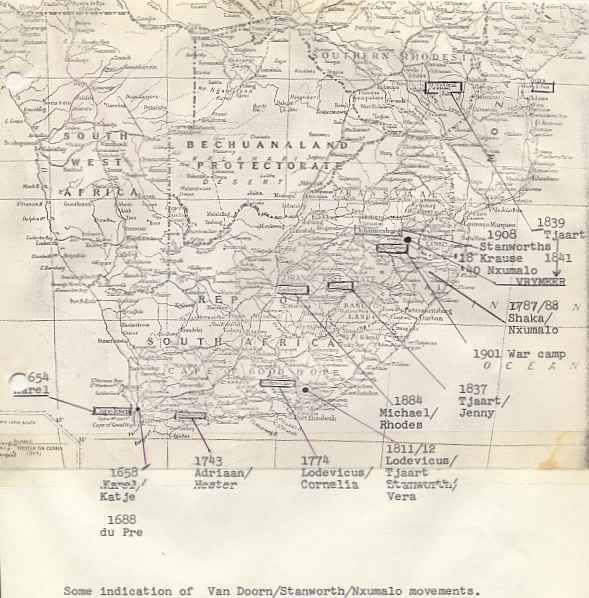
The Covenant : Outlining James Michener's novel
Michener brought a notebook to the table; I had a ruled scribbling block in front of me. I'd arrived with a carload of books from my library that offered a broad, popular and objective background to historical and contemporary South African figures and issues, as well as a ready reference for the many topics we would cover. Thus armed, we went to work on the novel.
One of the first keys we sought was the locale and "movement" of the story, essentially on an axis from Cape Town to Zimbabwe. We mapped out twelve stages along that imaginary route coinciding with the periodicity of South African history, essentially the unfolding of the frontier as settlers penetrated north. A movement that would, of course, come up against a counter migration of Xhosa and Zulu flowing down toward the south.

Before these "hard" dates, there would be scenes set on the living veld eons before man's arrival at Vrymeer (Lake of Freedom,) home to Australopithecus and later Bush people (San) remembered in rock paintings in the hill caves of Vrymeer and its lovely lake, where Mal Adriaan van Doorn is first of his line to behold a promised land.
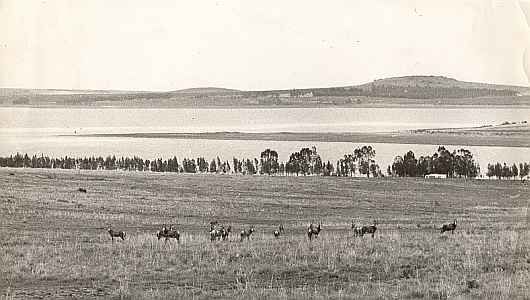
With this big picture in our sights, we could get down to the essentials: This we did chronologically, literally working our way through the decades of three centuries-plus of South Africa's recorded history, making stops in years and at events where we saw a role for our Van Doorns, Saltwoods and Nxumalos and those around them.
I have pages from my original scribbling block with penciled notes I made as Jim and I sat talking. - Names, dates, lines, squiggles, scratches and scrawls, which were subsequently transferred to a second and tidier pencil draft, then a third "yellow page" draft, a fourth revision of this, and finally the draft "Outline" to which Michener specifically refers.
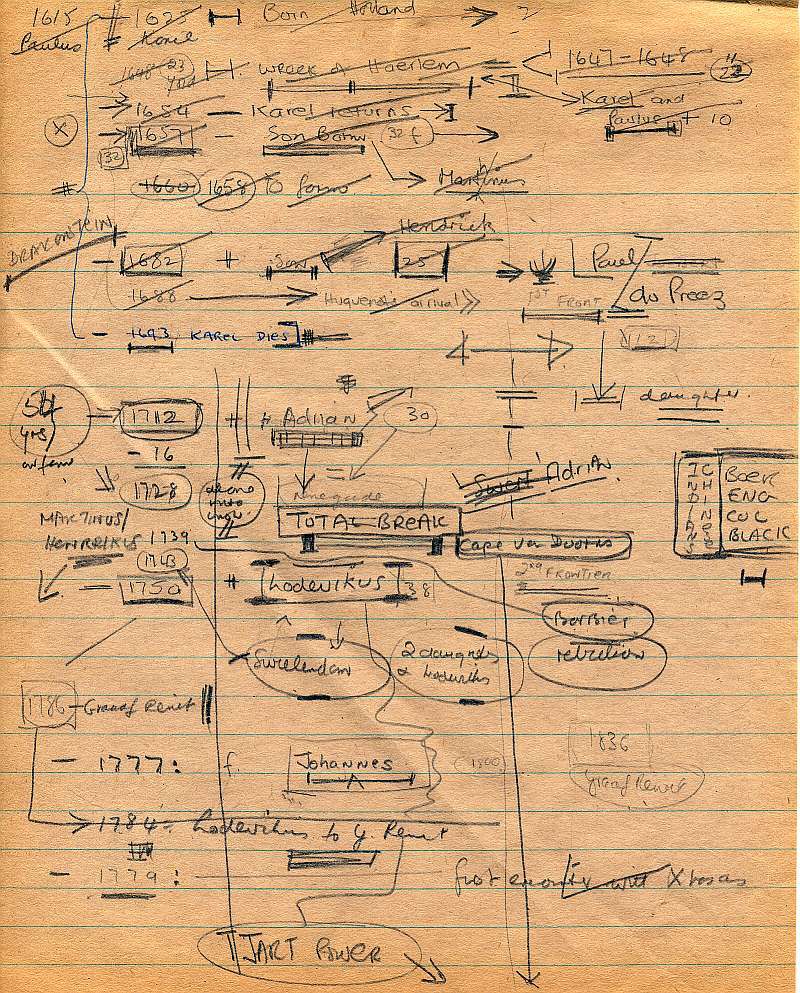
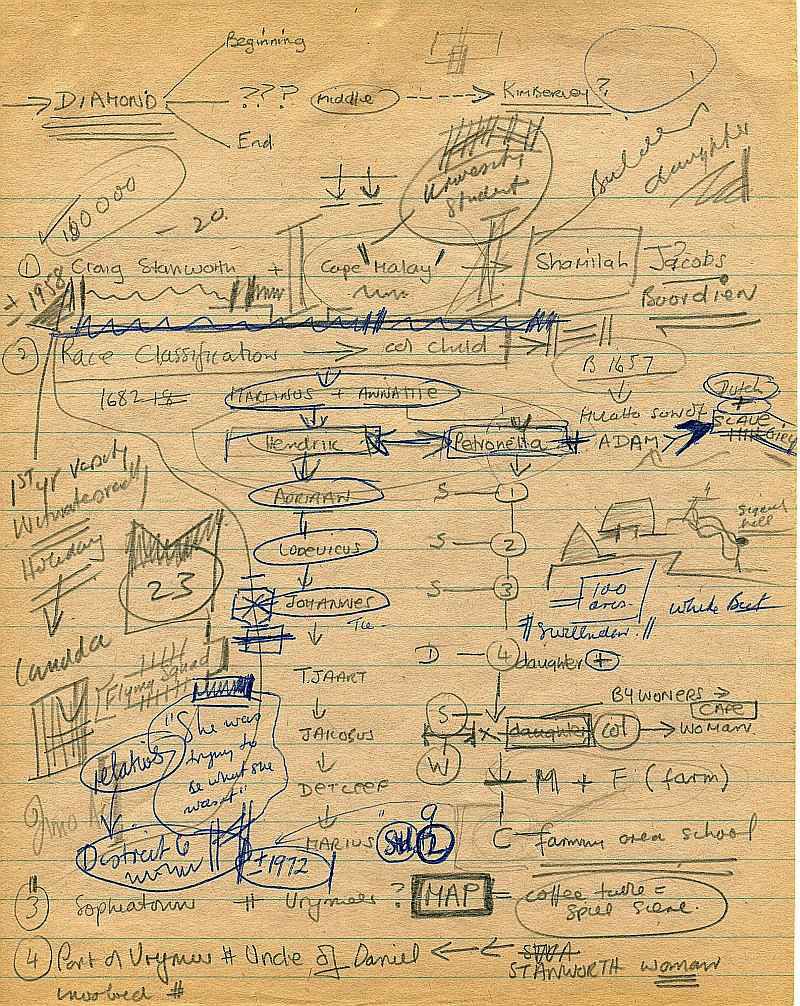
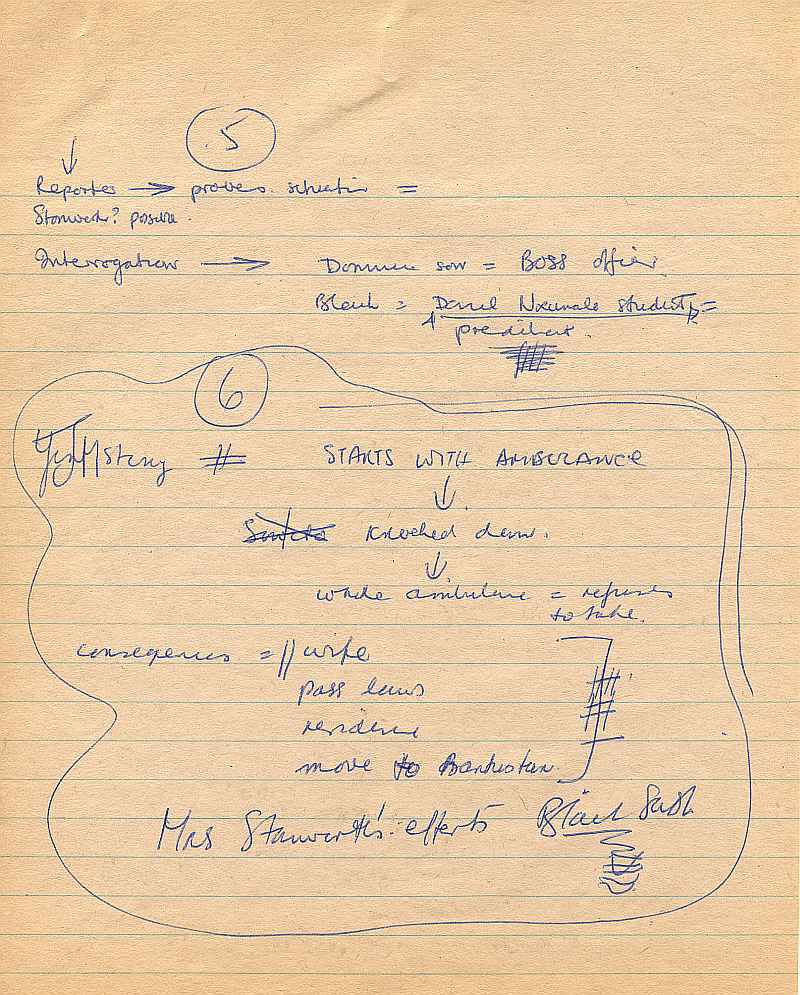
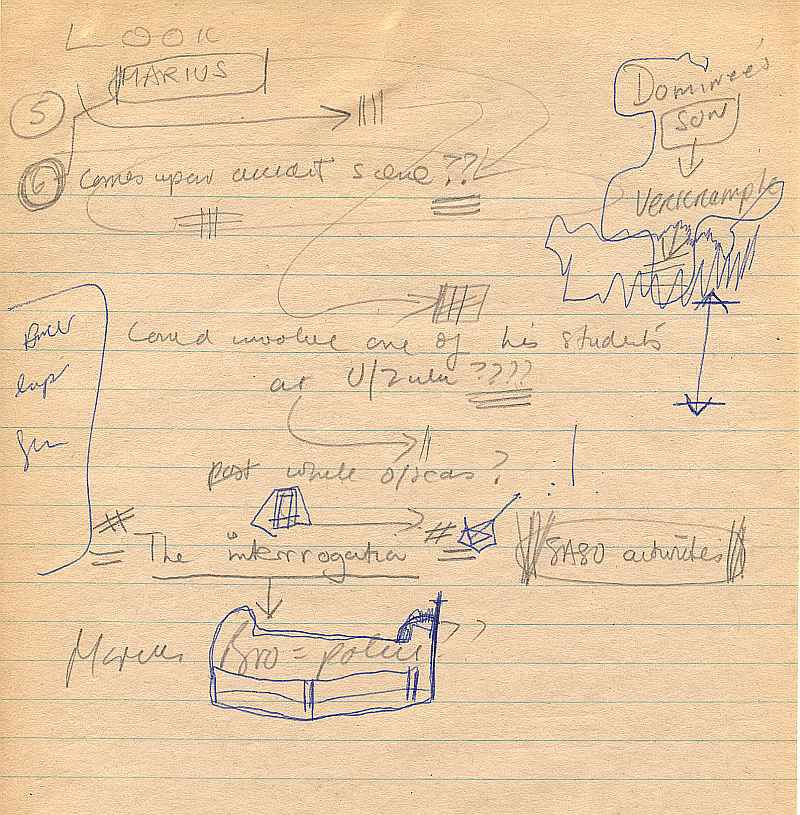
It was my idea to show the effect of apartheid on South Africans of all races with six vignettes of segregation and personal laws that affected citizens from birth to death. Key elements that would finally appear in the novel are in the scribbling black jottings above.
1)(Born) Immorality Act - Craig Stanworth ("Saltwood"), 20, first year varsity, Witwatersrand, holiday x Shamilah Jacobs, builder's daughter, Malay, university student, Flying Squad, Canada
2) Race Classification - Coloured child. "She was trying to be what she wasn't" + 1972 (Jotted down is a rough genealogical table that shows linkage between Van Doorns and the descendant of a black slave)
3)Group Areas - Sophiatown x Vrymeer? = MAP = coffee table = spill scene
4)Migratory Labor - Part of Vrymeer x Uncle of Daniel (Nxumalo) x Stanworth (Saltwood) woman involved.5)BOSS (Bureau of State Security) x reporter probes situation x Stanworth (Saltwood) x Interrogation x Dominee's son = BOSS officer x Daniel Nxumalo students at U Zululand x SASO activities.
6)Death - Marius? Comes on accident scene.Man knocked down. White ambulance refuses to take him x Consequences: wife x pass laws x residence x move to Bantustan x Mrs. Stanworth (Saltwood) efforts x Black Sash.
Never once did I say, 'So now we have this Englishman at the mission station in 1819. How does he get to the Orange River?' without Uys having nine or eleven possibilities, all good, all logical, all beautifully coordinated. Often I would say, 'too complicated for our boy,' or 'I doubt our boy would go so far,' but just as often I would say, 'That might be just what he'd do.'

As any writer knows, names can be critical in shaping a character in one's mind. So, for example, in the talk that led to "Mal ("Crazy") Adriaan," I named "Adriaan," for a whacky Afrikaner cousin, and similarly, Lodevicus "the Hammer" for an erstwhile colleague with a violent nature, the fictional Lodevicus becoming the scourge of the frontier Xhosa.
There's a Marius van Doorn in the apartheid era, a good man whose image was derived from another Marius I knew in Cape Town - Marius Barnard, an enlightened Afrikaner surgeon who saw the writing on the wall long before others did. If I look at the Saltwoods, I see Anthony and Susan and Clara, Roger and Timothy, Michael and Craig, and Marius Van Doorn and Claire Howard, all with a very familiar ring in my circle - names I jotted down on a check book deposit slip used as scrap paper amid the plottings!
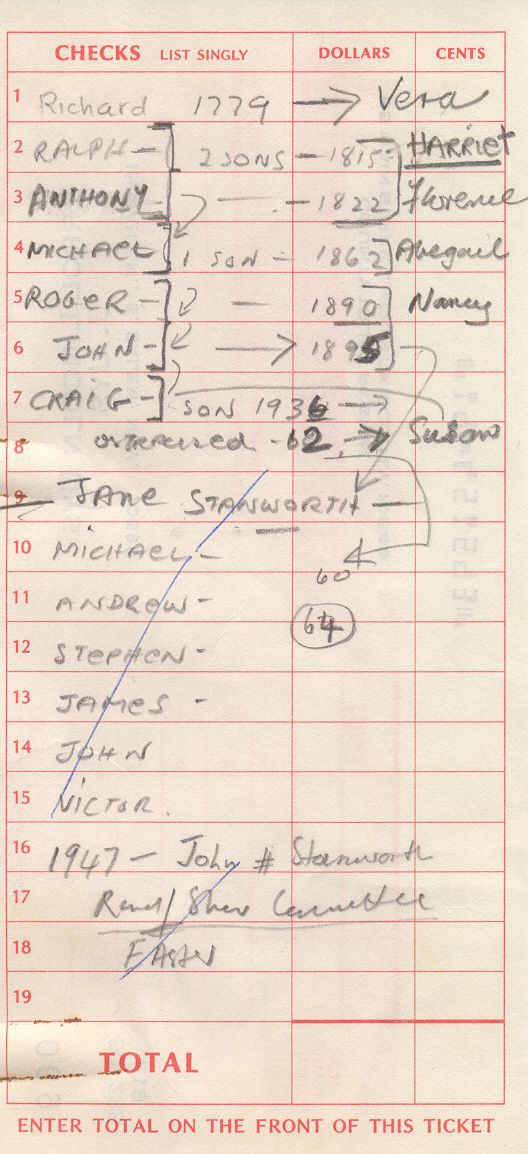
At the end of the first week, I moved out of the studio to spend the weekend in a hotel at St. Michaels, Jim and Mari having guests who were staying over. Over the three days, I wrote what I call the "yellow draft," my first outline for the book that incorporated the broad ideas from our initial exhaustive sessions, plus additions of my own that occurred to me as I worked with the notes I'd jotted down.
The plotline is chronological with dates of characters' births/deaths/ marriages and significant events touching their lives, both historical and personal. The first family trees for the Van Doorns, Saltwoods (Stanworths) and Nxumalo's appear here, as well as my first notation for a possible title: Covenant.
The clean-typed yellow pages provided the basis for our second four-day brainstorming. Once again, we began at the very beginning, as I note in this synopsis's "Chapter One:"
"Creation: The Diamond, the land, from dawn of time... to the arrival of Early Man. Emphasis on the mystical/almost supernatural value of the Diamond. Site: Present-day Blinkfontein - "sparkling fountain" - farm."
I've crossed out "Blinkfontein" and replaced it with a new name for the farm: Vrymeer, an Afrikaans word meaning "Lake of Freedom." This was a far more meaningful title for the property of the Van Doorns given the irony of a land where the struggle for freedom had been and was then still so bitter a battle.
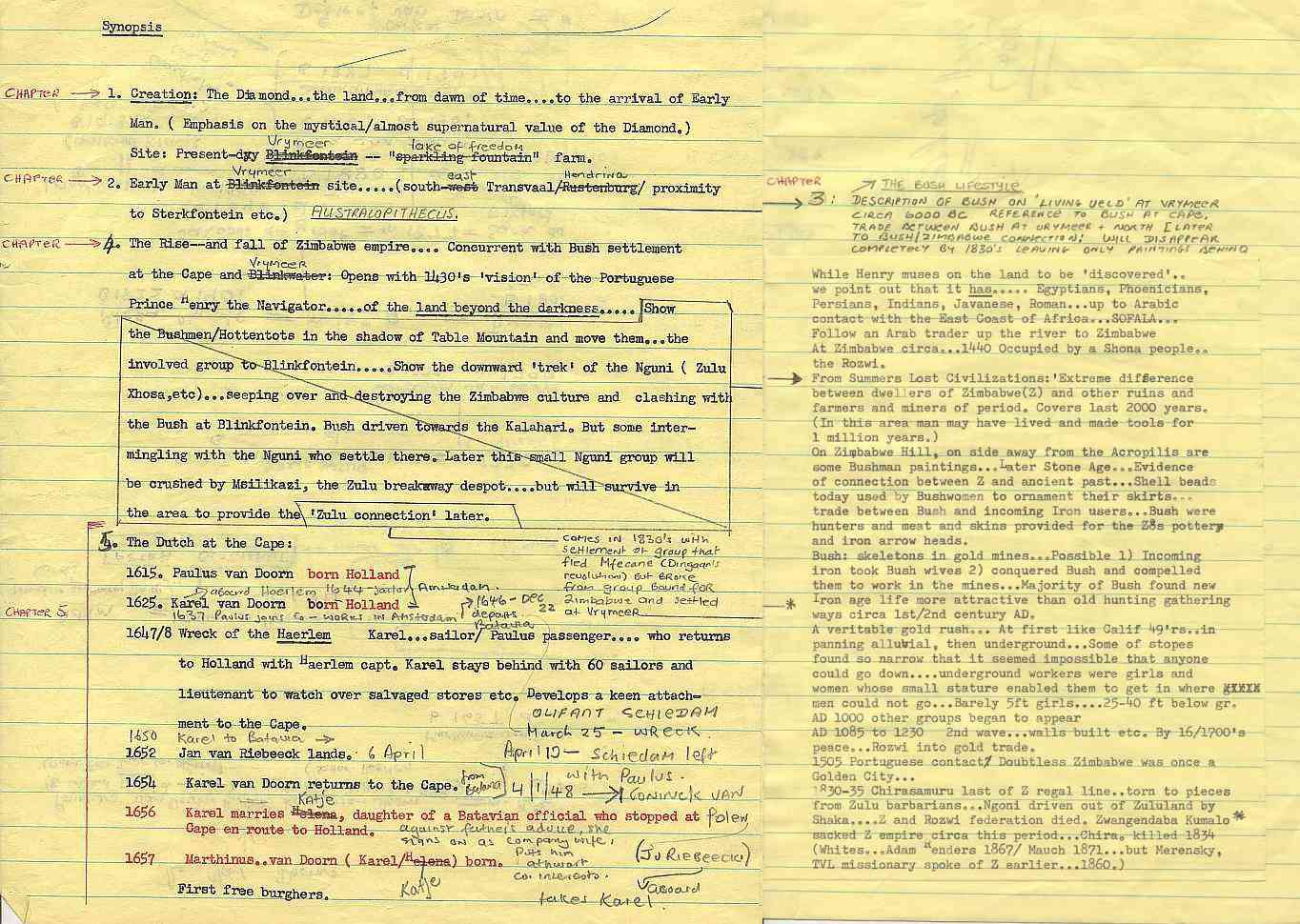
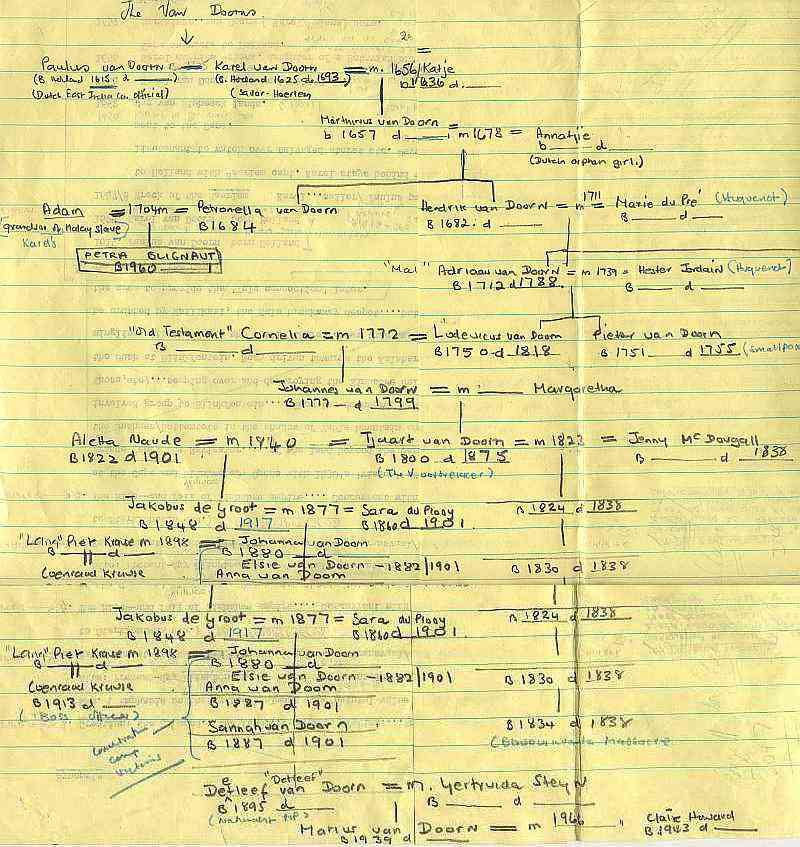
Glancing over the yellow draft today, I get echoes of Michener and me shaping core themes that stayed the course of the novel: The Bush people (San) on the living veld at Vrymeer, their connection with Zimbabwe and the Cape; Portuguese Prince Henry the Navigator's vision of the "land beyond the darkness;" the "gold rush" of great and ancient Zimbabwe; the timing of the southward “trek” of the Nguni (Bantu)and its importance in debunking the empty land myth; the Hedge of Bitter Almond at the Cape and heavy symbolism of "separatism;" the total break between Mal Adrian and the Cape van Doorns in 1728, "presaging later divisions in the ranks of Afrikaners and the split between a “liberal” south and “verkrampte” north (literally, cramped or narrow-minded;) Adrian's tremendous vision of Southern Africa stretching to the Zambesi, and from ocean to ocean; the black "Boers" of the South African War; Detleef van Doorn's "education," his rise through the ranks of Afrikanerdom and work as architect of apartheid; Moses and Daniel Nxumalo from 1948 to Soweto 1976, with Moses as servant of the Saltwoods, among other steps on an epic road.
And our thoughts on the conclusion: "Probably around Vrymeer... Nearby a splendid diamond is found. Not the one in the creation. The reader knows that it exists but it will not be found. It is symbolic of the notion that Africa herself is Master of all destinies here... The American to be introduced at a later stage. A geologist who makes the discovery of the diamond... He has been working in an African state for a company with ties to South Africa's Anglo American. About to return to U.S., he is offered a geology post in South Africa for one year. Provides opportunity for "outsider" view, desperately seeking answers to the race questions that plague him... and the threads that must lead to the diamond pipe on Vrymeer.
Here, too, I expanded my thoughts for the Apartheid chapter scratched out on the scribbling block:
Apartheid (Uys - Yellow Draft)
After death of Detleef content that he has protected South Africa . What did Detleef's Grand Design mean in the lives of citizens:
• BORN... Immorality Act.Case history. 1950 Act: Colored/White, see English family.Craig, age 20, student at University of Witwatersrand to Cape Town for December vacation. At Clifton Beach meets Shamilah Boordien, daughter of Cape Malay builder and wife. Summer holiday affair, meets parents, house Signal Hill etc. She is at UCT (before University of Western Cape.) She has been involved (with white) once before. On Clifton Beach does not "play white" but flaunts Apartheid. Craig takes her to Radnor-style hotel (*ELU= hotel where I stayed while living in Cape Town in 1964.) Housekeeper blows whistle on them. Arrested under Immorality Act. He gets suspended sentence; she is jailed. After her sentence to Canada-family there.• WHO ARE YOU... Race Classification 1950 Act: Case of young girl.
PETRONELLA van Doorn (daughter of Marthinus van Doorn, married ADAM, son of salve woman and Dutchman)
+S (1) Adrian
+S (2) Lodevicus
+S (3) Johannes
+D (4) Tjaart
+S (5) Jakobus x Coloured woman x Bywoner (sharecropper) Mother + White Afrikaner
+D (6) girl aged 9 = PETRA
At time of inquiry = 1 Coloured grandparent
Newcomers from Transvaal,see 9 year old at school, start inquiry
Child reclassified Coloured + mother Coloured
Farm bought by inquiry instigator
To District 6 x razed to ground, 1970-72 + move + girl 13/14, raped• WHERE YOU ARE... Group Areas mass removal..1950 Act. Mass removal of Indians from Johannesburg
Sophiatown witness, Barney Desait, Patel, '46
Repatriation offer (to India)
Lenasia, 22 miles from city
Pageview
Home: Fordsburg/Diagonal Street
• YOUR WORK... Migratory Labor Laws.black case.
Gold mine, migratory labor, compound, from Transvaal x NE, Zimbabwe connection, tribal man x life and times on Mine Compound
• YOUR THOUGHTS... BOSS operation (Bureau of State Security)
The Interrogation
Reporter probes story x parallel
Dominee's son x verkrampte x boss officer
Classic Boss interrogation
Black = Nxumalo student/University of Zululand
• YOUR DEATH... Ambulance service apartheid anecdotes/separate cemeteries etc.
Starts with ambulance apartheid
Man, black, knocked down and ambulance, whites-only, refuses to pick upConsequences: wife, pass laws, residence, moved to plot in Bantustan
Jane Stanworth's efforts, age 66